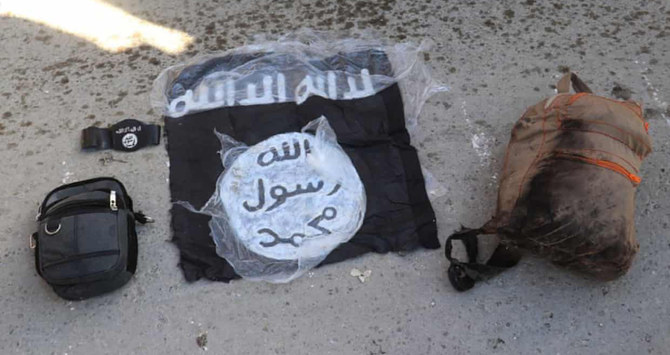The attack last month on the Kurdish-controlled Ghweyran prison in northeast Syria by 100 Daesh extremists, eerily reminiscent of the 2013 Abu Ghraib jailbreak, was the most sophisticated operation by the terroristssince their supposed defeat three years ago. There were woeful failures to detect and act decisively on the telltale signs of an impending attack.
Daesh has morphed into a formidable global security threat for an international coalition that appears to be asleep at the wheel. A disconnect persists between the frequency and lethality of attacks by Daesh militants, and the global response. These gaps, along with power vacuums on the ground, have allowed militant cells to survive and continue operating in the unpoliced swaths of Syrian and Iraqi territory.
Slow and ineffectual global intervention emboldens independent Daesh-linked cells to attempt increasingly brazen attacks, despite their limited resources and the absence of strong overall leadership. The crippling consensus view is that while attacks are on the rise, Daesh is overall not as powerful as it was during its peak eight years ago. While that may be true, the troubling result is a shared lack of interest in strategies to counter a reemergent Daesh.
This insistence on post-crisis interventions instead of preventive strategies by the global anti-Daesh coalition risks an accelerated return of Daesh. Because of the failure to remedy glaring shortfalls in intelligence, security, and governance, the Daesh threat will continue to evolve and metastasize, with disastrous consequences. The coalition must revisit its broad mission scope, which has been undermined by a myopic focus on the kinetic rather than the power vacuums created by its members’ tensions, rivalries, and mismatched interests.
In Syria, nonexistent security infrastructure has left villages at the mercy of extortion schemes, and intimidation by marauding militant cells.
Hafed Al-Ghwell
For instance, Daesh-linked militant cells actively operate in parts of Iraq where a veritable “no man’s land”exists between the Iraqi army, Kurdish forces, and Shiite militia checkpoints. With gaps that are tens of kilometers wide, mobile cells of no more than 15 Daesh fighters can maneuver freely in disputed areas where the Iraqi army, the Kurdish Peshmerga forces, and Iran-backed Shiite militias argue over who has control over them. Worse yet, despite the enduring presence of a common enemy, all three struggle to coordinate responses and mobilize for sophisticated counterinsurgency operations against nimbler Daesh cells because they often do not recognize each other’s authority.
In Syria, where the Ghweyran prison attack took place, parts of contested, less-populated territories face a similar situation. Nonexistent security infrastructure or law enforcement have left villages and towns at the mercy of raids, extortion schemes, and intimidation by marauding militant cells. These groups have found a way to thrive amid the usual confusion and vacuums typical of contested lands, taking advantage of the multidimensional fissures, many of which fueled Syria’s drawn-out conflict, to recruit support from some localities while unleashing terror on others. In addition, Syrian regime forces, Iran-backed militias, and US-backed Kurdish forces are more likely to train their guns on each other than to combine efforts to confront a shared adversary.
If these weaknesses remain unaddressed at the highest level, Daesh will engineer a comeback in these gaps and quickly overwhelm a squabbling and ill-equipped coalition. In Iraq alone, forces aligned with several foreign countries remain in control of different areas under the guise of counterterrorism and counterinsurgency cooperation. However, proxy militias aligned with Tehran have a dual purpose of securing what have now become vital border crossings, guaranteeing unfettered access to funnel men, money, and munitions into the Syrian conflict and for Iran’s Lebanese proxy, Hezbollah.
Meanwhile, Turkish bases in Iraq have become launchpads for drone attacks on Kurdish positions, even though the Syrian Democratic Forces are the most effective front-line combatants against Daesh. Ghweyran prison is one of up to 14 SDF-controlled detention facilities housing close to 12,000 inmates with ties to Daesh. Strangely, even after Daesh’s defeat, members of the global anti-Daesh coalition appear to have turned on each other or resorted to pursuing self-interest regardless of their long-term costs. As a result, the coalition is failing to mobilize against an evolving threat that is poised to continue growing, given fundamental flaws such as the outsourcing of Daesh prison-keeping to Kurdish militias faced with a possible US exit and escalating attacks by Turkish forces.
In addition, the inhuman conditions at the detention facilities and the makeshift camps for more than 60,000 family members of Daesh-linked inmates are fueling anger and resentment. The futility of repatriation attempts and the lack of legal processes also make Daesh recruiters’ task easier.
The overall narrative emerging from northeast Syria is that the Ghweyran prison attack is merely the latest spasm of an organization nearing its demise. Of course, such views may be justified, but more needs to be done beyond parroting talking points. For a supposedly dying organization, Daesh still managed to hold on to a major detention facility for almost a week before a combined force of US troops and SDF fighters retook it.There was sophisticated coordination by at least five groups before the attack, which involved a decoy bombing of a nearby fuel depot, road closures, and a well-timed prisoner riot. From a security standpoint, such an ambitious attack was more than a desperate lunge by a single militant cell seeking glory. Instead, it had the hallmarks of the careful planning and coordination reminiscent of Daesh’s heydays, matched with relentless ambition.
Unfortunately, the Ghweyran attack is unlikely to spur any monumental shifts in a global counterterrorism posture primarily stuck in neutral. Even the prevalence of active Daesh affiliates from Turkey to Afghanistan, the Philippines, Libya, and Nigeria has not provoked questions about how and why a supposedly defeated group retains the capacity to launch such attacks.
If nothing happens, there will be more attacks on detention facilities — boosted by remnants or offshoots, providing Daesh with the operational capacity, logistics, planning, coordination, and disguised strength to execute complex plans targeting sophisticated and protected locations. The ultimate folly would be failing to view the Ghweyran assault in a broader context beyond simply putting out fires and hoping for the best. Without renewed engagement, Daesh will reemerge, establish itself and consolidate its operations — having learned from by its defeat, and manned by hardened, formerly imprisoned fighters.
By: Hafed Al-Ghwell is a senior fellow with the Foreign Policy Institute at the John Hopkins University School of Advanced International Studies.
Twitter: @HafedAlGhwell
Source: Arab News
***Show us some LOVE by sharing it!***



